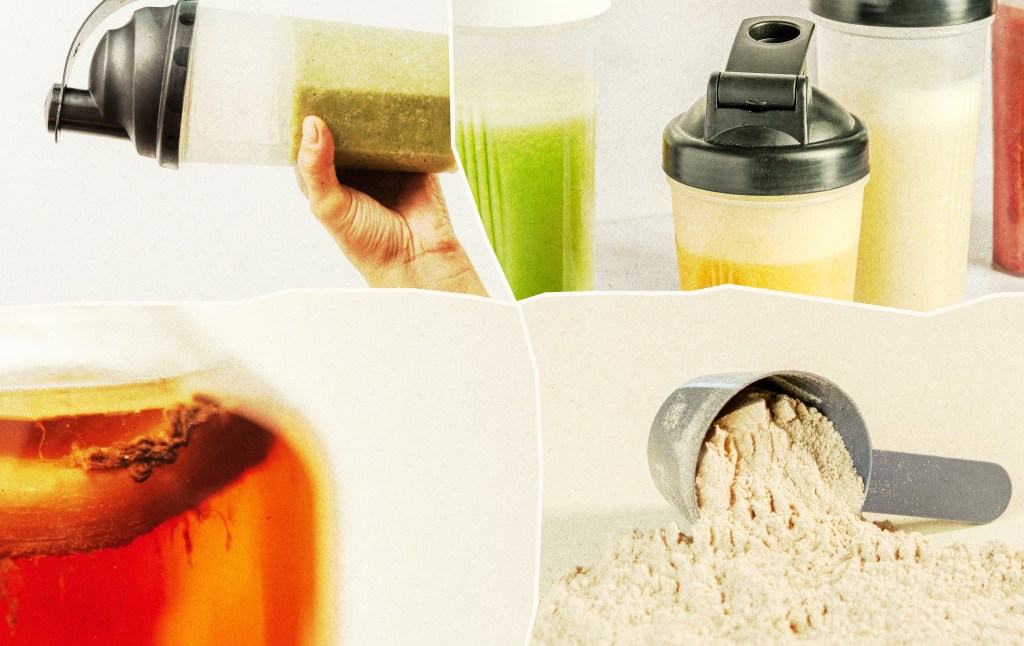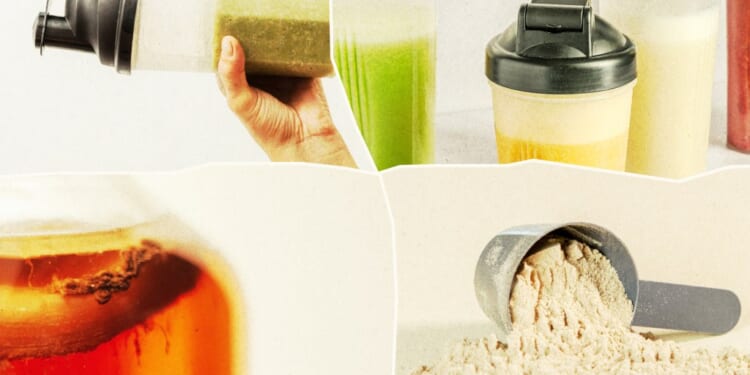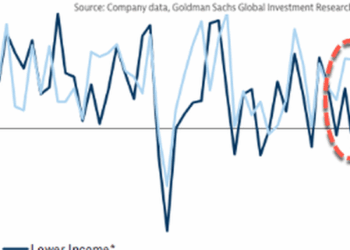
When the wellness influencer Rhonda Patrick showed up on my X feed touting the virtues of creatine, I felt very tired.
This was no coincidence. I am the mother of two girls, ages 4 years and 6 months. The baby was teething and waking up wailing every two hours each night. The preschooler was being a preschooler, asking more questions in a day than I wanted to answer in a year. And suddenly here was this video, summarizing the results of a study that claimed that creatine, a supplement that athletes often use to sustain muscle energy during intense exercise, reverses the effects of maternity-related exhaustion. “One high dose (25–30 grams) of creatine rapidly reverses (and even surpasses) the cognitive deficits caused by severe sleep deprivation,” Patrick tweeted.
The supplement is not snake oil, she said. It’s backed by science: “In controlled studies, people given a high-dose creatine supplement after 21 hours of sleep deprivation not only recovered their cognitive abilities, they performed better than their baseline (fully rested) levels.” Scores of moms replied to Daniel’s tweet, saying that creatine is the mother’s wonder drug.
Like any mother who is even marginally online, I’m no stranger to supplement trends marketed to women. Since my first prenatal appointment in 2021, I’ve progressed from eating simple gummy vitamins to gulping down a rotating cast of iron, vitamins, Omega-3 fish oils, magnesium, probiotics, and more kinds of protein powder than I care to count. Many of them gave me unenviable gastrointestinal results and thus sit in the cabinet, gathering dust, to this day. A few seem to help, or at least not hurt, and I dutifully swallow them every evening before dinner.
But that gulp gets more and more reluctant with each new wellness fad. My cabinet of unused supplements is just my personal portrait of the massive online marketplace for female biohacking, the idea that with the right trick—the right pill or powder or morning ritual or workout routine—women can unlock perfect health.
Creatine is just the latest in a long line of consumable biohacking products. It’s popping up everywhere that probiotics were just months ago—powders, gummies, bars, sodas, and mocktails.
Like many supplements, the anecdotal accounts are out ahead of research on their real benefits, and Twitter and health blogs are out ahead of the FDA’s official recommendations. The posts on the subject due their due diligence and list the caveats: “There are no high-quality human studies showing that creatine is unsafe for breastfeeding mothers or infants, but there is also a lack of direct research confirming safety during lactation.” And then they launch into the benefits: “neuroprotective effects” that could “benefit moms experiencing ‘mom brain’ or postpartum fatigue,” “muscle repair and regeneration” to “aid tissue healing,” and so on. It’s up to you, the individual, to draw your own conclusions.
And when you, the individual, are an exhausted mother, the conclusion tends to look like this: “Basically a dream for anyone who is pregnant, let alone a pregnant mom with young children,” one mother responded to Patrick’s tweet. When another X user asked whether the mother used creatine during breastfeeding, she replied, “I honestly cannot remember if I did because I feel like I lost all will to stay on top of supplements despite it being recommended, but I plan to do so this time!” Both the amnesia and the good intentions are revealing: The fog that we derisively call “mom brain” is indeed induced by simple exhaustion. But it’s likely worsened by the ever-growing proliferation of supposed solutions on offer, and the expectation that each individual keeps up with the latest fads as the price of good health.
In its endorsement of an ever-growing range of wellness boosters, female supplementation may not seem like a revolutionary trend, and it isn’t. The gym bros have been mixing every imaginable kind of muscle-building compound into their workout recovery drinks for decades. Female influencers such as Gwyneth Paltrow have biohacks for the female wellness market with brands like Goop. The pitch goes like this: Biohacking, if you do it right, leads to gains that you couldn’t have by eating normal food. You’ll be stronger, or live longer, or emerge from a day of chasing small children around pulsing with energy.
Rather than a revolution, female biohacking is the extension of a fitness mindset to a sex whose health choices come with added responsibility: Take the right pill, find the right trick, and not only will you be healthier, but your children will be too, thanks to your increased energy, better fertility, richer breastmilk quality, and on and on. If you don’t, or if, heaven forbid, you pick the wrong supplement, well, the logic isn’t complicated. Your failure to find the right supplement regime is now not just a personal failure but bad parenting too.
Health-maxxing can just be another form of overwork—and one fueled just as much by guilt as a desire for health or strength. So it’s easy to see, following this line of thinking (read: marketing), why women get hooked on supplements. And it’s just as easy to see why they get burned out. There’s always fresh research or a new product selling the potential for not only personal wellness but bountiful motherhood. It would be foolish—and irresponsible—not to at least check it out, right?
As the female market for supplements grows, the lifestyle prescribed for its consumers expands from eating into action. The rise of the weighted vest describes the other side of biohacking: exercise, and the attendant products that serve as amulets not just to increase present wellness now but to stave off ill health later. Long used for military and police training, weighted vests have recently taken off among women wanting to get a better calorie burn out of their daily walks. The influencer Dr. Mary Claire Haver was one of the first to promote them for older women, pointing to the importance of strength training in preventing bone loss during menopause. (Though as one doctor told the New York Times, “It’s not a trade for traditional full-body resistance training.”)
The market for weighted vests reached an estimated $205 million last year, which is expected to grow to $350 million within the next decade. Sixteen percent of millennial and Gen Z women in a recent survey said they’ve worn one, compared to 6 percent of Gen X women and 2 percent of boomers. Last month, a post on Goop’s website titled “I Wore a Weighted Vest Every Day for a Month—Here’s What Happened” finally explained to me why so many women were walking around Northern Virginia in what I had thought were bulletproof vests. It wasn’t a political statement about the state of law and order in and around our nation’s capital: They were protecting themselves against a more nebulous danger by buying into the latest biohacking trend.
So when Genevieve Howland—aka Mama Natural, the creator of a popular online birth and parenting course for moms on the crunchier side—started touting weighted vests in her newsletter, I wasn’t as surprised as I should have been. This is the woman who taught me how to give birth at home without medication: no epidural, no drugs, maybe not even Tylenol. I clicked on a newsletter on exercise earlier this month to find that “strength training is a MUST for moms.” So far, so natural. But then Howland added this advice: “Think weighted vests, babywearing while walking, or traditional weight lifting.” And later, she repeated: “Add resistance by walking with a weighted vest or babywearing as your little one grows.”
At least one of these recommendations strikes me as not very natural. While Howland is right that strength is essential for mothering, often the mothering is the strength training. Here’s a sample workout: Wrestle baby into fresh diaper, wrestle baby into car seat, wrestle preschooler into car seat, heft car seat onto stroller frame, cart kids and groceries around store, heft groceries into car, hold baby while unloading groceries with one arm, make lunch with one arm, clean up from lunch—also with one arm. All of that amounts to about an hour in the life of a typical mom who, circa 2025, now apparently needs a weighted vest to attain sufficient strength for her current and future health. Give me a break.
Actually, it turns out that taking breaks may be the most important component of strength training. The women’s weight-lifting guru Casey Johnston, for example, describes in her recent book A Physical Education her surprise at learning how much rest—days off of everything from cardio to that quick grocery store run for milk and eggs—is required for muscles to rebuild themselves. “The thing about muscles is that they are not actually built during workouts,” Johnston writes. “When muscles move weights, their fibers get broken down and shredded up over the course of a workout.”
What really builds muscle is not the workout but the healing process that follows. “It’s the repair process that rebuilds them to be better than before, and this is the crucial part of the cycle that actually creates new strength,” Johnston says. “None of this repair can happen without time and space; a body that is still active and giving output can’t manage its input.”
Johnston was used to running every day, mostly to stave off the guilt that came from not running. But the constant work was doing nothing more than keeping her constantly working. Now, she calls resting “the best but also most challenging part” of strength training.
It’s certainly the most neglected one, and it has been for a long time. Johnston recounts experiments dating back to the Industrial Revolution geared toward the “optimization” of human beings: experiments with rats’ blood to formulate a “fatigue vaccine,” prescribing “nerve whips” (aka cocaine and caffeine) to boost productivity. But in the end, the longed-for gains ranged from the negligible to the destructive: There was “no hacking or manipulating the biological fact that people could not go and go forever,” Johnston writes.
The biohacking mindset assumes that the pursuit of boundless energy and perfect health is mothers’ duty to themselves and their children. But is it? In their quest to overcome all the tiresome challenges of daily life, moms should not forget their greatest strength is the opposite of treating food as mere fuel and the body as a simple machine. They are in the business of nurturing people, not powering machines. They should extend themselves that same grace—a grace that cannot be bought or sold, and has no convenient supplement.

















